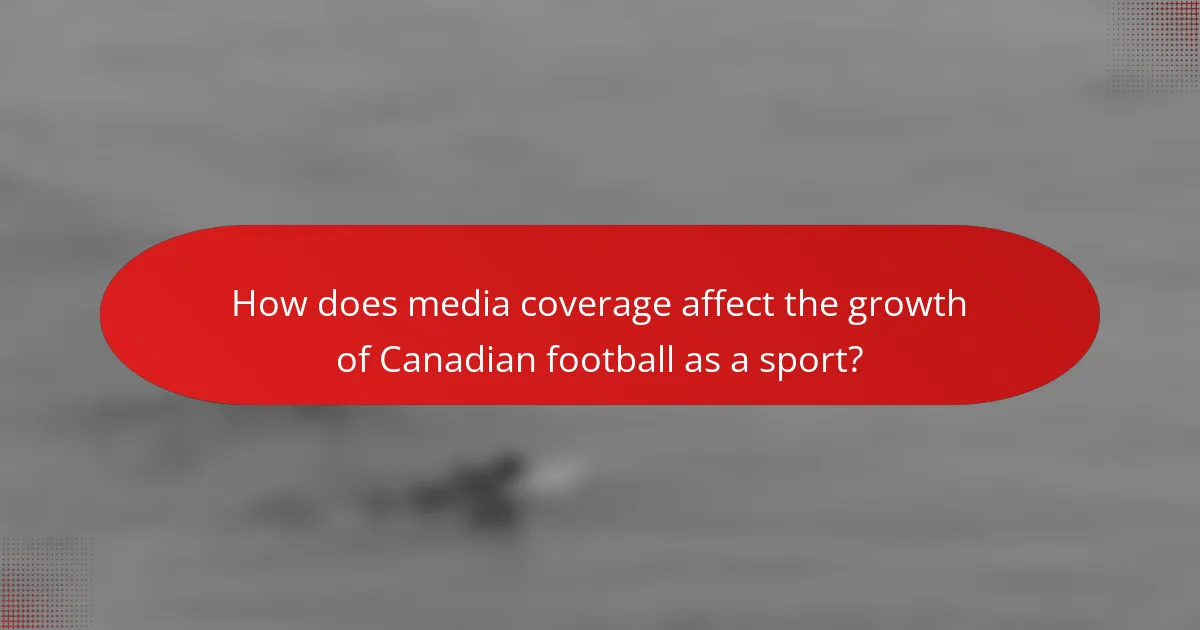Canadian football media coverage plays a crucial role in shaping public perception and fan engagement. It emphasizes local narratives and player stories, fostering community identity. The quality and tone of reporting can significantly influence team popularity and attendance. Additionally, the sport’s cultural significance and media strategies, including social media engagement, enhance visibility and participation.

How does Canadian football media coverage shape public perception?
Canadian football media coverage significantly shapes public perception by influencing fan engagement and community identity. Coverage highlights key narratives, such as team rivalries and player stories, which foster emotional connections. As a result, media portrayal can enhance or diminish the popularity of teams and players.
The unique attribute of Canadian football media is its focus on local stories, which resonate deeply with regional audiences. This localized approach strengthens community ties and encourages attendance at games. Furthermore, media coverage often emphasizes the sport’s cultural significance, framing it as a vital part of Canadian heritage.
Public perception is also affected by the quality and tone of coverage. Positive reporting can boost a team’s image, while negative stories may lead to decreased support. Metrics show that teams with favorable media attention experience higher attendance and merchandise sales.
Overall, Canadian football media serves as a powerful tool that shapes not only public perception but also the broader cultural landscape surrounding the sport.
What are the key channels for Canadian football media coverage?
The key channels for Canadian football media coverage include television, radio, online platforms, and social media. Television networks like TSN and Sportsnet provide extensive game coverage and analysis. Radio stations offer live commentary and discussions. Online platforms, including team websites and sports news outlets, deliver articles, highlights, and updates. Social media channels engage fans through real-time interactions and content sharing. These channels significantly influence public perception and engagement with Canadian football.
How do audience demographics influence media engagement?
Audience demographics significantly influence media engagement in Canadian football. Different age groups, genders, and cultural backgrounds shape how individuals interact with media coverage.
Younger audiences, particularly those aged 18-34, often prefer digital platforms for content consumption, leading to increased online engagement. This demographic values interactive content, such as social media highlights and live updates. In contrast, older demographics may favor traditional media, resulting in different engagement patterns.
Additionally, gender plays a role in media preferences. Research indicates that male audiences are more likely to engage with in-depth analysis and statistics, while female audiences may prioritize storytelling and community aspects. This divergence can affect how media outlets tailor their coverage.
Cultural backgrounds also impact engagement. Diverse communities may seek representation in media narratives, influencing their connection to the sport. Understanding these demographics allows media organizations to create targeted content, enhancing public perception and engagement with Canadian football.

Which factors drive the popularity of Canadian football in media narratives?
The popularity of Canadian football in media narratives is driven by its cultural significance, community engagement, and competitive spirit. Media coverage often highlights local teams, player stories, and community events, fostering a sense of belonging.
Moreover, Canadian football’s unique attributes, such as its distinct rules and style of play, attract diverse audiences. The league’s efforts to promote inclusivity and accessibility further enhance public interest.
As a result, the combination of cultural relevance and engaging storytelling in media narratives amplifies Canadian football’s visibility and appeal, influencing public perception positively.
What role do major events play in shaping media coverage?
Major events significantly shape Canadian football media coverage by enhancing public interest and engagement. High-profile games and championships attract extensive media attention, influencing how audiences perceive the sport. Coverage often emphasizes key players, team rivalries, and dramatic moments, creating narratives that resonate with fans. As a result, media portrayal can elevate the popularity of Canadian football, driving viewership and participation. Major events also provide platforms for discussing broader social issues, further engaging audiences in meaningful ways.
How does social media impact fan engagement and perception?
Social media significantly enhances fan engagement and shapes public perception of Canadian football. Platforms like Twitter and Instagram allow fans to interact directly with teams and players, fostering a sense of community. This engagement boosts visibility and creates a dialogue around games and events.
Social media also influences how fans perceive the sport. Positive interactions and content shared by teams can enhance enthusiasm and loyalty. Conversely, negative coverage can lead to skepticism or disinterest. The immediacy of social media means that public sentiment can shift rapidly based on trending topics or viral moments.
Moreover, analytics show that Canadian football teams with active social media strategies see higher attendance and merchandise sales. Engaging content, such as behind-the-scenes footage or player interviews, attracts more followers and keeps fans invested in the team’s journey. This dynamic illustrates the crucial role social media plays in modern sports marketing and fan relations.

What are the unique characteristics of Canadian football media coverage compared to other sports?
Canadian football media coverage is distinct due to its regional focus, community engagement, and unique storytelling. Unlike other sports, it emphasizes local narratives and player connections. Coverage often highlights the cultural significance of the game, fostering a strong sense of community identity. Additionally, Canadian football media utilizes platforms like social media to enhance fan interaction, driving engagement and loyalty. This approach contrasts with broader sports media, which may prioritize national or international narratives.
How do regional teams influence local media narratives?
Regional teams significantly shape local media narratives by tailoring coverage to community interests and values. This localized focus fosters deeper engagement among fans and influences public perception of the Canadian Football League (CFL). Regional narratives often highlight local player stories, team performance, and community events, creating a sense of belonging. As a result, fans feel more connected to their teams, enhancing loyalty and participation in local events. This dynamic illustrates how regional media acts as a bridge between the CFL and its diverse fan base, driving both interest and engagement.
What are the distinct storytelling techniques used in Canadian football coverage?
Canadian football coverage employs distinct storytelling techniques that shape public perception and engagement. These techniques include personal narratives that connect fans to players, strategic use of statistics to highlight performance, and cultural references that resonate with Canadian identity. Additionally, visual storytelling through dynamic broadcasts enhances viewer engagement by creating an immersive experience.

How does media coverage affect the growth of Canadian football as a sport?
Media coverage significantly boosts the growth of Canadian football by enhancing public perception and engagement. Increased visibility through various media channels leads to greater fan interest and participation.
Positive media narratives can elevate the sport’s profile, attracting sponsorships and investment. For instance, coverage of major events like the Grey Cup garners national attention, showcasing the league’s competitiveness and entertainment value.
Social media platforms further amplify this effect, allowing fans to engage directly with teams and players. This interaction fosters a sense of community and loyalty, crucial for the sport’s growth.
Statistics show that regions with higher media coverage report increased attendance at games and youth participation in football programs, highlighting the direct correlation between media presence and sport development.
What are the implications of media representation for youth engagement?
Media representation significantly shapes youth engagement in Canadian football by influencing perceptions and interest levels. Positive portrayals can increase participation and support, while negative images may discourage involvement. Studies show that diverse representation enhances relatability and encourages youth to engage with the sport. Furthermore, media narratives that highlight role models can inspire young fans, promoting a culture of inclusivity and community around Canadian football.
How does media coverage influence sponsorship and investment in the sport?
Media coverage significantly boosts sponsorship and investment in Canadian football by shaping public perception and engagement. Positive media narratives elevate the sport’s visibility, attracting potential sponsors seeking to associate with popular events. Increased coverage fosters a larger fan base, enhancing ticket sales and merchandise revenue, which further entices investors. For instance, a well-publicized game can lead to a spike in attendance, showcasing the sport’s growth potential. As a result, brands recognize the value of aligning with a thriving entity, leading to increased financial support and long-term partnerships.

What challenges does Canadian football media coverage face in 2025?
Canadian football media coverage faces challenges in 2025, including competition from other sports, limited resources, and audience engagement issues. These factors hinder the growth and visibility of the sport. The dominance of major leagues like the NFL overshadows Canadian football, affecting media attention. Additionally, budget constraints limit the depth of coverage and analysis. Engaging younger audiences remains a struggle, as they gravitate towards more popular sports and entertainment options. Addressing these challenges is crucial for enhancing public perception and engagement with Canadian football.
How do changing viewer habits impact traditional media formats?
Changing viewer habits significantly impact traditional media formats by shifting audience engagement from linear broadcasts to digital platforms. As Canadian football media coverage evolves, it increasingly prioritizes online streaming and social media interaction. This transition influences public perception, as fans expect real-time updates and personalized content. The growing preference for on-demand viewing alters how traditional broadcasters approach coverage, often leading to innovative formats that integrate viewer feedback and enhance engagement. Consequently, traditional media must adapt to maintain relevance in a rapidly changing landscape.
What are the common misconceptions perpetuated by media coverage?
Media coverage of Canadian football often perpetuates misconceptions that distort public perception. One common misconception is that the sport lacks popularity compared to other North American leagues. In reality, Canadian football has a dedicated fan base and significant viewership, especially during the Grey Cup.
Another misconception is the belief that the quality of play is inferior. However, many players in the Canadian Football League possess high skill levels and have previously played in the NFL. Additionally, media narratives sometimes emphasize negative incidents, overshadowing the positive community impact of the sport.
Misleading portrayals can also create a perception of exclusivity, suggesting that Canadian football is only for a specific demographic. In truth, the sport fosters inclusivity and participation across various communities. These misconceptions can hinder engagement and appreciation for Canadian football.

What best practices can enhance Canadian football media coverage?
To enhance Canadian football media coverage, focus on strategic partnerships, diverse content creation, and audience engagement initiatives. Collaborating with local influencers can broaden reach and foster community ties. Producing varied content, such as podcasts and interactive social media, caters to different audience preferences. Engaging fans through polls and live Q&A sessions boosts involvement and loyalty.
How can media outlets improve audience engagement strategies?
Media outlets can enhance audience engagement by focusing on tailored content, interactive platforms, and community involvement. They should prioritize local stories to resonate with fans. Utilizing social media for real-time updates fosters immediate interaction. Collaborating with influencers can broaden reach and attract diverse demographics.
Engaging storytelling that highlights player journeys and team history can deepen emotional connections. Incorporating analytics to understand audience preferences allows for data-driven content strategies, ensuring relevance. Hosting live events or Q&A sessions encourages direct participation, strengthening community ties.
What innovative formats can be adopted for better storytelling?
Innovative formats for storytelling in Canadian football media coverage include interactive graphics, podcasts, and social media snippets. These formats enhance audience engagement by providing immersive experiences and real-time updates. For instance, interactive graphics can visualize player statistics and game highlights, making complex data more accessible. Podcasts offer in-depth discussions and analysis, appealing to auditory learners. Social media snippets deliver quick, shareable content that keeps fans connected. Adopting these formats can shift public perception by creating a more dynamic narrative around the sport.
